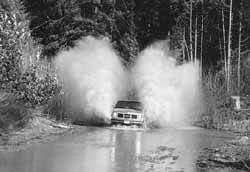Waterproofing
 By:
Dean Bradley
By:
Dean Bradley
Waterproofing your vehicle is essential to maintain long term reliability. It may also give you the confidence to tackle deep water crossings without fear of engine failure.
To waterproof your vehicle requires attention to the engine intake/electrical, and the drivetrain (axles, transmission and transfercase). If you have or are contemplating driving in water deeper than 30 cm. (12 inches), the following modifications are a necessity.
Axles are the first parts in the driveline to be submerged upon entering deep water or mud. Axles are easier to modify than the transmission or transfercase, due to easier access to the vent tubes located on the housings. All differentials, transmissions and transfercases need a vent due to the changes in temperature created by the gear oil.
Factory vent fittings are located on the surface of the housing or casing and consist of a small threaded fitting with a metal capped vent. Remove the vent & fitting and replace with threaded male fitting for a hose. You will also need two hose clamps and a filter with a male fitting.
Route the breather away from moving parts and exhaust and incorporate enough length into the tube to compensate for suspension stretch. Note: extra length is not needed for transmission and transfercase, as they don't move. Place the breathers high in the rear of the engine compartment or in the corners of the body or if possible into the cab. It's possible to join transmission and transfercase breathers with a "T" fitting and use only one breather (refer to shop manual if you are having difficulty finding vent tubes). Make sure you place breather vents higher than anticipated water depth.
It is vital that your engine air intake avoids water. Remember, water will not compress like gas. If submerged, the engine may suck water into the cylinders, which almost certainly will bend internal components such as piston connecting rods, destroying the engine. This is also known as 'hydraulicking' your motor.
 If
you ever feel than your engine may have gone too deep, turn it off immediately.
It's better to be safe than sorry. A few seconds is all it takes to suck
water in through the carburetor or fuel injection once submerged.
If
you ever feel than your engine may have gone too deep, turn it off immediately.
It's better to be safe than sorry. A few seconds is all it takes to suck
water in through the carburetor or fuel injection once submerged.
Going through water too fast will also splash water upwards inside the engine compartment, so keep your speed down while submerged. If you suspect water has entered the engine, pull it out to a safe place. Remove all the spark plugs and turn the motor over until all the water is ejected out through the plug holes, then reinsert spark plugs and restart. Remember also water can be sucked up the exhaust pipes, especially with headers and free flowing exhaust. If you turn off the motor while submerged, without the exhaust pressure the steel of your exhaust super cools, pulling the water up into the engine through the exhaust ports. Never stop in the middle for a "photo shoot" and turn off the motor, or you may have an unpleasant surprise.
Some vehicles (particularly newer ones) have the air intake facing forward in the grill. This is the worst location. When entering deep water from or even shallow water from a steep angle, the grill area dives in first and becomes engulfed in water due to a bow wake or just from the angle of entry. By the time your rear wheels enter and your vehicle levels out, it is too late. Keep the inlet away from splashing water or submerging. Face the inlet backwards inside the engine compartment - the air is somewhat hotter, but there's much less chance of water getting in there.
The distributor can also become wet. If it does, simply remove the cap and spray WD-40 inside, which will disperse the water and evaporate quickly. Re-attach the cap and start.
The fan spraying water around the engine compartment may cause a wet distributor. With older vehicles, one option to prevent this is to disconnect the fan belt before starting a deep-water crossing. Unfortunately newer vehicles use serpentine style belts, which once removed will also eliminate your power steering and alternator. Another choice is to remove the mechanical fan before you leave home and install an electric fan instead. Then just before crossing any deep water, you can just switch it off or remove the fuse to turn off the fan.
Flex fans should usually be avoided because if it contacts water, it can bend towards the radiator and damage both the rad and your day.
Remember, always check water depth before entering. When crossing water (particularly rivers), avoid soft grassy areas, do not spin your tires, and enter and exit at the shortest crossing. Always drive slowly to reduce the bow wake created by your vehicle. When the crossing is complete, it is a good idea to ride the brakes slightly to help dry them off so they work properly afterwards.